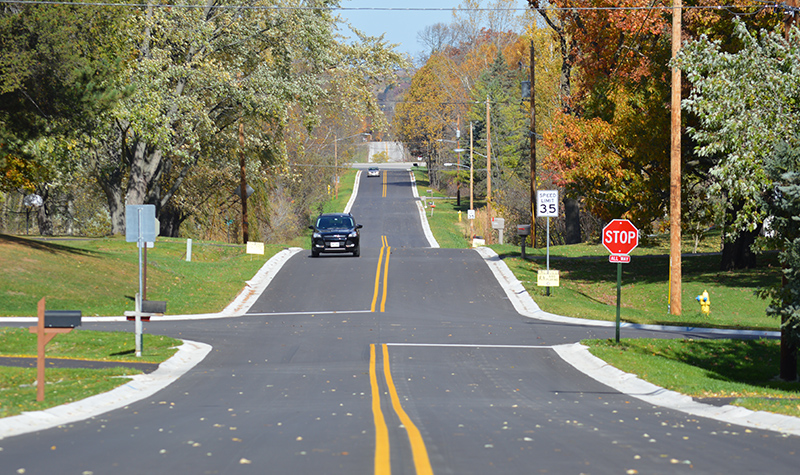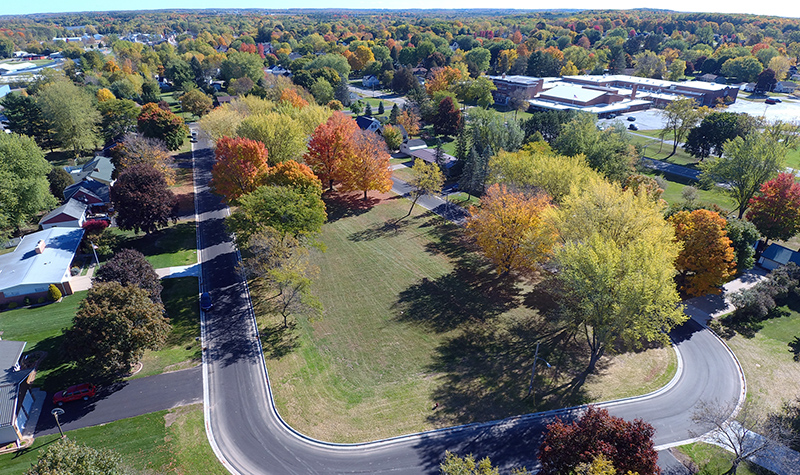Converting Rural Streets to Urban:
What are the Design Considerations?

As communities improve their failing streets and infrastructure, we find more are seeking to urbanize their rural typical roadway sections.

About the Expert:
Contact Trace Hubbard, PE, is a civil engineer in Ayres’ Green Bay area office. He has worked on several rural-to-urban roadway improvement projects in Wisconsin, including North McCarthy Road in Grand Chute, Hillcrest Drive in Green Bay, Menasha Street in Reedsville, and Orchard Circle/Harding Avenue in Gillett. His duties include design and construction phase tasks on municipal and transportation projects.
What is a Rural Section vs. an Urban Section?
A stretch of road classified as rural usually has no curb and gutter and uses ditches along the sides of the road to carry stormwater that runs off the road and nearby property. These ditches, when flowing properly, will keep the road from flooding.
When rural roads are turned into urban sections, curb and gutter is added to direct the stormwater runoff, usually into a storm sewer system or a holding place for that water, such as a detention pond. Pedestrian and bicycle accommodations are often considered more with an urban section, ranging from on-street bike lanes to crosswalks to sidewalks and multi-use paths along the sides of the road.
What are the Design Considerations?
While most road transformations from rural to urban share many common elements, each project comes with unique challenges and solutions.
Stormwater Management
Stormwater management is a major concern for municipalities, developers, and industries. Engineers have to consider many regulations controlling the quantity and quality of stormwater runoff. Those regulations often come with governmental red tape, so having experienced stormwater engineers is crucial to keeping a project schedule on track.
Fortunately, there are relatively easy, low-cost systems to handle stormwater runoff. Best management practices (BMPs) are techniques or methods of water pollution control that manage the quantity and improve the quality of stormwater runoff. See our related blog on BMPs and the differences between stormwater detention and retention facilities.

Urbanization projects also present the unique constraint that in most cases existing stormwater runoff is conveyed, treated, and infiltrated in existing vegetated swales. With the removal of vegetated swales and the installation of curb and gutter and storm sewer, this treatment and infiltration is often no longer possible. In states such as Wisconsin, projects over an acre in size are considered redevelopments and are required to reduce the total suspended solids (TSS) in the stormwater on the site by 40%. Depending on the community, jurisdiction, or the region of the state, more stringent requirements, such as total phosphorus (TP) removal may also be required.
Engineers must evaluate and determine the requirements to be met before determining the type of stormwater management feature (BMP) to propose. Depending on how much space is available, treatment options may range from a wet detention pond, bioretention area, or an underground detention system.
Right-of-way and Property Constraints
Communities looking to urbanize a street often hit roadblocks when looking to expand the footprint of the street by adding curb and gutter, bike lanes, sidewalks, two-way turn lanes, or other features. The width of the property that the municipality owns – or right-of-way – must be considered early in the process. Property acquisitions from landowners outside the right-of-way can greatly drive up the cost of a road project. Temporary and permanent easements are other tools to be used when dealing with property issues.
The presence of wetlands along a road project can also be a major constraint. Laws dictate how much a project can affect wetlands and what must be done to offset those effects.
Elevation Issues
One of the greatest challenges in converting a rural section of roadway to urban is that there is no consistency in the elevation between the roadway and the surrounding property. The existing roadway can be higher, lower, or level with the adjacent property. In many cases one side of the roadway is also higher or lower than the other.

Establishing a proper urban section by eliminating ditches and allowing for overland flow of water away from adjacent properties to the roadway is not always possible. Engineers have to develop a best-fit type design that will balance existing topography and grading impacts to nearby properties, keeping in mind the goal is to provide smooth transitions and limit steep slopes. In situations where drainage to the roadway is not achievable, stormwater conveyance can be accomplished through the addition of yard drains or swales behind the curb.
User Safety Considerations
An urban section of road often comes with added concerns for keeping all users safe because of the increased presence of pedestrians and bicyclists. Engineers take a close look at traffic volumes, vehicle speeds, crash data, turning movements, driveway access, and other factors that go into keeping all users safe.
Some of the design tools available to keep all users safe on a rural to urban conversion include:
- Reducing speed limits.
- Providing an appropriately sized terrace between the roadway and pedestrian accommodations.
- Adding crosswalks and potentially signals.
- Traffic calming devices.
- Meeting Americans with Disabilities Act (ADA) requirements on walks/trails and ramps.
Contact Trace Hubbard, PE, for more information regarding urbanizing rural typical roadway sections.

Post a comment: